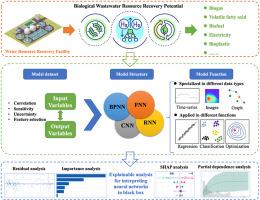用于生物废水资源回收的数据驱动神经网络:发展与挑战
IF 10
1区 环境科学与生态学
Q1 ENGINEERING, ENVIRONMENTAL
引用次数: 0
摘要
由于碳中和的要求,从废水中回收资源受到越来越多的关注。生物资源回收过程的数学模拟和污水处理厂(WWTP)的智能控制是将传统污水处理厂转变为水资源回收设施(WRRF)的关键。虽然活性污泥模型和厌氧消化模型等机理模型已得到广泛应用,但在模拟机理未知的复杂微生物驱动废水资源回收过程时,数据驱动模型,特别是神经网络,优于机理模型。因此,本综述重点介绍神经网络(包括浅层神经网络和深度神经网络)在废水生物资源回收领域的发展和应用现状。首先介绍神经网络的基本发展和结构。然后,对神经网络在从废水中回收沼气、挥发性脂肪酸、生物燃料、电力和生物塑料方面的应用现状进行了评述。分析了与资源生产相关的重要输入变量,并强调了为神经网络准备数据集的重要性。此外,还讨论了神经网络的复杂性,以指导从废水中回收资源的神经网络的跨学科发展。最后,提出了目前神经网络在这一跨学科领域的局限性和前景。神经网络在全规模 WRRF 中的应用仍然有限,因此有必要进一步研究和加强努力,以提高其实际应用水平。神经网络与机理模型的结合为进一步解决这一跨学科领域的实际建模问题提供了巨大潜力。本综述将为利用浅层和深层神经网络来模拟和优化生物废水资源回收过程提供指导。本文章由计算机程序翻译,如有差异,请以英文原文为准。

Data-driven neural networks for biological wastewater resource recovery: Development and challenges
Recovering resources from wastewater has received increasing attention due to the requirement of carbon neutrality. The mathematical simulation of biological resource recovery processes and the intelligent control of wastewater treatment plants (WWTPs) are crucial for transforming traditional WWTPs into water resource recovery facilities (WRRFs). Although mechanistic models such as the activated sludge model and anaerobic digestion model have been widely applied, data-driven models, especially neural networks, outperform the mechanistic models in modeling intricate microbe-driven wastewater resource recovery processes with unknown mechanisms. Therefore, this review focuses on the development and current applications of neural networks including shallow and deep neural networks in the field of biological resource recovery from wastewater. The basic development and structures of neural networks are introduced first. Then, the current applications of neural networks in recovering biogas, volatile fatty acids, biofuel, electricity and bioplastic from wastewater are critically reviewed. The important input variables related to resource production are analyzed and the importance of preparing datasets for neural networks is highlighted. Moreover, the complexity of neural networks is discussed to guide the interdisciplinary development of neural networks in recovering resources from wastewater. Finally, the current limitations and perspectives of neural networks in this interdisciplinary field are proposed. The implementation of neural networks in full-scale WRRFs remains limited, necessitating further research and intensified efforts to enhance their practical applications. The combination of neural networks with mechanistic models presents great potential to further address practical modeling issues in this interdisciplinary field. This review would provide guidance for utilizing shallow and deep neural networks to model and optimize biological wastewater resource recovery processes.
求助全文
通过发布文献求助,成功后即可免费获取论文全文。
去求助
来源期刊

Journal of Cleaner Production
环境科学-工程:环境
CiteScore
20.40
自引率
9.00%
发文量
4720
审稿时长
111 days
期刊介绍:
The Journal of Cleaner Production is an international, transdisciplinary journal that addresses and discusses theoretical and practical Cleaner Production, Environmental, and Sustainability issues. It aims to help societies become more sustainable by focusing on the concept of 'Cleaner Production', which aims at preventing waste production and increasing efficiencies in energy, water, resources, and human capital use. The journal serves as a platform for corporations, governments, education institutions, regions, and societies to engage in discussions and research related to Cleaner Production, environmental, and sustainability practices.
 求助内容:
求助内容: 应助结果提醒方式:
应助结果提醒方式:


